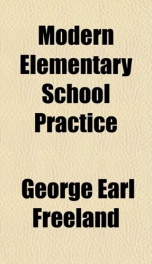modern elementary school practice

Purchase of this book includes free trial access to www.million-books.com where you can read more than a million books for free. This is an OCR edition with typos. Excerpt from book: CHAPTER III THE PROJECT Characteristics, Uses, and Values Problem and Project. As explained before, the project is different from the problem in that its essential feature is the provision of something to organize, investigate, or accomplish, rather than to stimulate thought. It may be a problem or a part of a problem, and it may embrace problems. The more good problems a project affords the better it is for educational purposes. To afford something to do, the project must necessarily arise from the interests of the children. The method may be illustrated by quoting a description of its use in the Horace Mann School. George D. von Hofe says, " The sixth-grade pupils in the Horace Mann school are studying science regardless of every artificial division. The class chooses a project, something that has attracted attention and in which they are vitally interested. The teacher then presents the information to follow not the so-called logical development found in textbooks, but the trend of thought of the pupils." 1 It is not possible to separate the project from the problem method. Some persons define the project as the" end-point " of the problem. Many of the illustrations given in the preceding chapter could be called projects. However, the project view adds distinctly to the success of problems. 1 Teachers College Record, May, 1916, pp. 240-246. Provides for Longer Assignment. The distinct advantage of the project over the old topic or question and answer method is that it provides for continuous work on the part of the pupil rather than assignment from day to day. It thus allows for weighing values and organization of material along vital lines by both teacher and pupil. Consider these points in the following illustrations: Project in history: Territorial expa...
Info about the book
Author:
Series:
Unknown
ASIN:
B000L2AE44
Rating:
3.5/5 (4)Your rating:
0/5
Languge:
English
Users who have this book
Users who want this book
What readers are saying
What do you think? Write your own comment on this book!
write a commentif you like modern elementary school practice try:
Other books by this author
Do you want to read a book that interests you? It’s EASY!
Create an account and send a request for reading to other users on the Webpage of the book!

